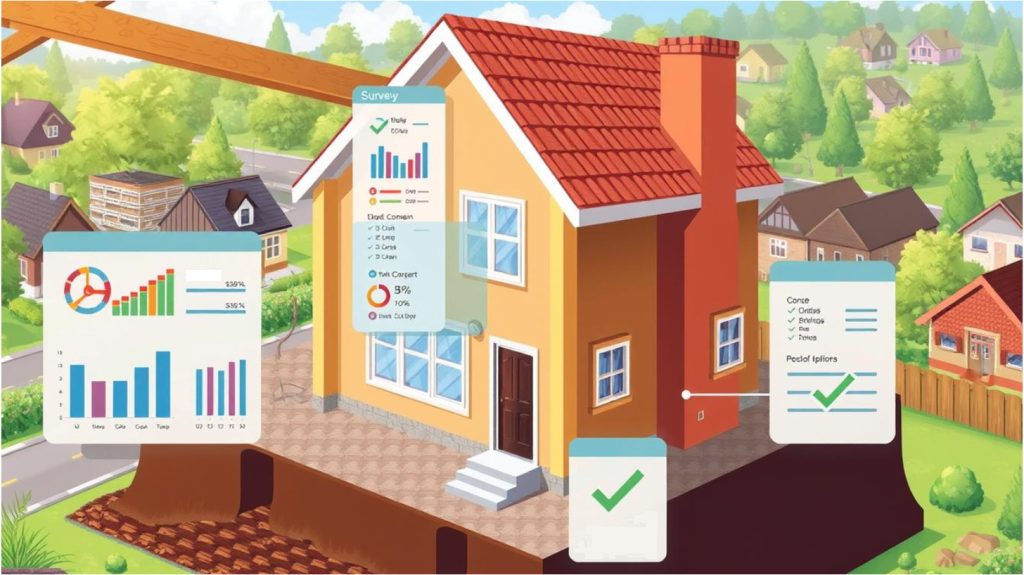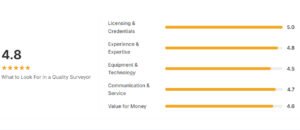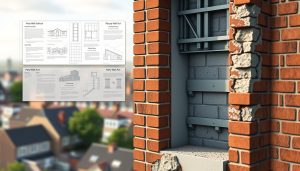In the UK, acquiring a homebuyers report or a structural survey (also known as a Full Building Survey) is vital for informed property purchases. The UK’s property market is complex, and the right survey can prevent unforeseen costs. A homebuyers report visually inspects the property, highlighting significant defects. In contrast, a structural survey provides a detailed analysis of the property’s condition.
For older properties or those requiring renovation, a structural survey is advisable. A homebuyers report, on the other hand, is ideal for secondhand homes with older structures. It is essential to understand the distinctions between these surveys to make an informed decision.
Key Takeaways
- Homebuyers reports provide a visual inspection of the property, identifying major defects or issues.
- Structural surveys offer a more detailed and thorough analysis of the property’s condition.
- A homebuyers report is suitable for many properties in regions like Lancashire, where a significant portion of the housing stock exceeds 100 years.
- A structural survey is recommended for older properties or those in need of renovation.
- Understanding the differences between a homebuyers report and a structural survey is critical for making the right choice in the UK property market.
- A homebuyers report is designed as a cost-effective option, whereas a structural survey can be more expensive due to its bespoke nature.
Understanding Property Surveys in the UK
In the UK, property surveys are essential for buyers to make well-informed decisions. The Royal Institution of Chartered Surveyors (RICS) dictates the standards for these evaluations. These surveys aim to assess a property’s condition and value. According to property surveys UK, they can uncover issues that might affect the property’s value or necessitate repairs.
There are several survey types available in the UK, such as Homebuyers Reports and Structural Surveys. These are conducted by certified surveyors who adhere to CIOB, RPSA and/or RICS standards. This ensures a detailed and precise assessment. The surveys reveal any defects or issues, enabling buyers to negotiate the price or request repairs before the sale.
The CIOB, RPSA and/or RICS standards for property surveys in the UK underscore the need for a meticulous assessment. This involves examining the building’s condition, including any defects or issues, and providing a detailed report. By adhering to these standards, buyers gain a thorough understanding of the property’s condition. This knowledge empowers them to make informed decisions about their purchase.
What is a Homebuyers Report?
A homebuyers report is a detailed visual inspection of a property, aimed at identifying significant defects or issues. It is less extensive than a structural survey but remains a valuable tool for prospective buyers. In the UK’s property market, it is a preferred option due to its cost-effectiveness. The average cost of such a report is approximately £700, significantly lower than the £900 to £1,500 range for a structural survey.
The report encompasses an evaluation of the property’s condition, highlighting any defects or issues that require attention. This includes assessments of the roof, walls, floors, and other structural components, as well as any dampness or other anomalies. It employs a traffic light system to summarise the property’s condition, indicating any areas of concern. The cost of the survey can fluctuate based on the property’s location, size, and age. Yet, a homebuyers report remains a prudent investment for those entering the UK property market.
Key advantages of a homebuyers report include:
- Identifying any major defects or issues with the property
- Providing a cost-effective way to assess the condition of a property
- Helping buyers to make an informed decision about their purchase
- Highlighting any areas of concern, such as signs of damp or structural issues
Compared to a structural survey, a homebuyers report is more budget-friendly. Yet, it remains a critical investment for anyone considering purchasing a property in the UK. It offers a concise and clear overview of the property’s condition, enabling buyers to avoid unforeseen expenses in the future.
| Survey Type | Cost Range |
|---|---|
| Condition Report (Level 1) | £500-£1,000 |
| Homebuyers Report (Level 2) | £600-£1,500 |
| Structural Survey (Level 3) | £700-£2,500+ |
Components of a Structural Survey
A structural survey offers a detailed examination of a property’s state, focusing on its structural integrity. It is vital for spotting issues like subsidence or heave and gauging repair costs. The survey delves into the property’s foundations, walls, floors, and roof, alongside its plumbing, electrical, and heating systems.
The assessment employs a meticulous visual inspection, both inside and out. It scrutinises the walls, floors, and ceilings, alongside the roof, gutters, and downspouts. Surveyors also look for damage or wear, such as wall cracks or ceiling water stains.
Detailed Building Analysis
A detailed building analysis is a cornerstone of a structural survey. It entails a thorough examination of the property’s construction, focusing on its foundations, walls, and roof. The surveyor evaluates the structural elements, like beams, joists, and rafters, to identify any weaknesses or defects.
Structural Assessment Methods
Structural assessment employs various techniques, including visual inspections, measurements, and tests. Surveyors might utilise tools like thermal imaging cameras or moisture meters to uncover hidden defects or issues.
Report Documentation
The final report summarises the survey’s findings, detailing any defects or issues. It includes repair or maintenance recommendations and cost estimates. This information is critical for buyers, sellers, and property owners, providing a clear view of the property’s condition and any associated risks or liabilities.
Structural surveys offer several benefits, including identifying issues early, estimating repair costs, and understanding the property’s condition. They enable buyers and sellers to make informed decisions, avoiding future problems. With a detailed analysis, thorough assessment methods, and a detailed report, a structural survey provides a reliable evaluation of a property’s state.
Comparing Homebuyers Report or Structural Survey: Key Differences
Understanding the distinctions between a homebuyers report and a structural survey is critical. A homebuyers report is less detailed, often chosen by most house buyers. In contrast, a full building survey, or structural survey, offers a detailed examination of the property, providing a ‘warts and all’ report.
Comparing these surveys, a homebuyers report visually inspects key elements like walls, roof, drainage, and bathrooms. It identifies common defects such as Japanese Knotweed, damp, service issues, and subsidence. A structural survey, on the other hand, is advised for properties with historical significance, known local issues, or unusual construction materials.
When deciding between a homebuyers report and a structural survey, several factors are important to consider:
- Scope of the survey: a homebuyers report is less detailed, while a structural survey covers every aspect of the property.
- Level of detail: a structural survey provides a more in-depth analysis of the property’s condition.
- Cost: a homebuyers report is generally less expensive than a structural survey.
The choice between a homebuyers report and a structural survey hinges on individual needs and circumstances. It is essential to weigh the comparison of these surveys and select the most suitable option. This ensures an informed decision regarding your property purchase.
Cost Implications and Value for Money
When contemplating the acquisition of a Homebuyers Report or a Structural Survey, it is imperative to weigh the survey costs against the long-term advantages. The expense of a survey fluctuates, influenced by the survey’s type and the property’s valuation. Typically, a Homebuyer Report ranges from £600 to £1,500, whereas a Structural Survey can be £700 to £2,500+ in cost.
A survey’s value lies in its ability to uncover latent issues with the property. This can empower buyers to negotiate a more favourable purchase price or sidestep expensive repairs in the future. The Royal Institution of Chartered Surveyors (RICS) notes that Homebuyers sometimes rely on a mortgage valuation report, forgetting that they need an independent building survey. A Home Buyers Survey can expose concealed repairs and structural flaws, potentially saving buyers substantial sums in future repair expenditures.
In summary, despite the initial survey expenses appearing considerable, the long-term benefits of a survey significantly outweigh these costs. By selecting the appropriate survey, buyers can make an informed choice, mitigating against unforeseen pitfalls.
When to Choose a Homebuyers Report
A homebuyers report is ideal for newer properties or those in excellent condition. Recent data reveals that UK house buyers spend an average of £5,750 on repairs when moving into a new home. This highlights the importance of selecting the correct survey type to prevent unforeseen expenses. It is advisable for properties under 100 years old, as it offers a condition rating system with three categories: red (requires further action), amber (may require attention), and green (everything is fine).
Properties such as conventional homes, flats, or bungalows in good condition are well-suited for a homebuyers report. This survey is recommended for newer builds or when a general overview of the property’s condition is desired. The survey duration is approximately 2 to 4 hours, depending on the property’s size and condition, making it a swift and efficient process.

Homebuyers reports are generally less costly than building surveys, making them a more budget-friendly option for buyers. It is vital to weigh the benefits of each survey type and select the one that aligns with the buyer’s requirements. A homebuyers report is often the preferred choice in scenarios such as:
- Purchasing a newer property with no major structural issues
- Buying a property that has been well-maintained
- Looking for a general overview of the property’s condition
The decision to opt for a homebuyers report hinges on the buyer’s specific needs and the property’s characteristics. By considering the most suitable property types and common scenarios, buyers can make an informed choice, avoiding unexpected expenses in the future.
Situations Requiring a Structural Survey
A structural survey is essential in specific scenarios, mainly for older properties or those with known defects. The HomeOwners Alliance notes that properties from earlier eras often present issues in reports. In such situations requiring a detailed examination, a structural survey offers critical insights into the property’s state.
Some property types are more apt for a structural survey than others. For example, older homes or those with distinctive architectural elements may benefit from a more meticulous inspection. The following are scenarios where a structural survey is advisable:
- Properties with known defects or damage
- Older homes, specially those constructed before 1800
- Properties with unusual architectural features
- Homes that have been extended or modified
In these situations requiring a structural survey, selecting a qualified surveyor is critical. The surveyor will assess the property’s condition, pinpointing any possible issues and suggesting repair or maintenance options. By opting for a structural survey, homebuyers can make informed decisions and sidestep unexpected expenses later on.
Understanding which property types are typically suited to a structural survey aids homebuyers in making the correct choice for their needs. Whether you’re considering an older home or a unique property, a structural survey offers reassurance and aids in navigating the homebuying process confidently.
| Survey Level | Cost | Recommended For |
|---|---|---|
| Level 1 | £500 to £1,000 | Recently built homes in good condition |
| Level 2 | £600 to £1,500 | Properties built after 1980 with conventional materials |
| Level 3 | £700 to £2,500+ | Older or more expensive homes with possible building faults |
Finding and Choosing a Qualified Surveyor
In the quest for a qualified surveyor, several critical factors must be considered. A professional with the right qualifications is vital for an accurate and efficient survey. It is essential to discern the qualifications and experience of a surveyor to make an informed choice.
Starting with a surveyor regulated by either the Chartered Institute of Building (CIOB), Royal Institution of Chartered Surveyors (RICS) or Residential Property Surveyors Association (RPSA) is advisable. CIOB, RPSA and RICS ensures that surveyors adhere to professional standards. Look for MRPSA, MCIOB, MRICS or AssocRICS after their names, indicating adherence to these standards. Local knowledge is also a significant factor, more so when dealing with specific property types or issues.
When selecting a surveyor, several key factors should be considered:
- Professional qualifications and experience
- Local knowledge and expertise
- Sample reports and clarity of content
- Estimated timings for surveys and reports
- Cost and value for money
Requesting a sample report can provide insight into the surveyor’s reporting style and clarity. It is also beneficial to inquire about their experience with similar properties and specific concerns. By conducting thorough research, you can identify a qualified surveyor who meets your requirements and offers a detailed survey.
Choosing a qualified surveyor is critical for an accurate and efficient survey. Invest time in researching and selecting a surveyor with the appropriate qualifications and experience. This will ensure you receive the best service possible.
Understanding Survey Results
Upon receiving your survey results, it is imperative to grasp the report’s interpretation to make an informed decision regarding your property acquisition. The surveyor’s report will detail any common issues encountered during the inspection. These may include dampness, structural anomalies, or subsidence. The Homebuyer report employs a traffic light system for condition ratings. Red signifies serious defects, orange indicates non-urgent repair or replacement needs, and green signifies no immediate repairs are required.
The survey results offer a thorough analysis of the property’s condition, highlighting any defects or issues that demand attention. It is vital to meticulously review the report and pose questions if any aspect of the survey results remains unclear. The surveyor might suggest additional investigations or specialist reports, such as a damp survey or a structural engineer’s report. These are aimed at providing more in-depth information on specific issues.

- Damp: Commonly found, and often easily fixable
- Structural problems: Such as cracks in ceilings and walls
- Subsidence: Ground beneath the property sinking
The survey results offer a clear insight into the property’s condition, facilitating an informed decision-making process. By comprehending the survey results and report interpretation, you can identify any prospective issues. This enables you to take necessary steps to address them, ensuring a seamless and successful property acquisition.
Time Frames and Planning Your Survey
In the UK property market, the importance of survey time frames and planning are pertinent. The duration of a survey is influenced by several factors, including the property’s size and condition. For example, a Condition Report typically requires 1-2 hours, whereas a HomeBuyer Report can take 1-3 hours. A Building Survey, on the other hand, may take 2-5 hours to complete.
Understanding the specific survey type and property characteristics is essential. HomeBuyer’s Reports can be returned within 5 working days, whereas Full Structural Surveys take approximately 8 working days. Planning ahead is critical to avoid any delays in the buying process. Utilising a live diary system can ensure immediate access to a surveyor, aiming to reduce waiting times.
Key considerations for survey planning include:
- Survey duration: 1-4 hours for HomeBuyer’s Reports, 3-8 hours for Full Building Surveys
- Report return times: 2-3 working days for HomeBuyer’s Reports, 3-4 working days for Full Structural Surveys
- Property type and size: larger properties take longer to survey
By grasping the nuances of survey time frames and planning effectively, you can navigate the UK property market efficiently. Selecting the appropriate survey type for your property and planning ahead are fundamental to avoiding delays.
In conclusion, the survey process hinges on understanding time frames and planning. By considering the survey type, property characteristics, and size, you can ensure a successful experience in the UK property market.
| Survey Type | Duration | Report Return Time |
|---|---|---|
| Condition Report | 1-2 hours | Within 48 hours |
| HomeBuyer Report | 1-3 hours | 2-3 working days |
| Building Survey | 2-5 hours | 3-4 working days |
Making the Most of Your Survey Investment
Investing in a survey is a critical step in the home-buying process. It uncovers hidden issues, potentially saving you a significant amount of money. For instance, older homes or those with extensive renovations benefit greatly from a thorough building survey. This is supported by data from Havering property surveyors.
To maximise your survey investment, it’s imperative to pose the right questions to ask your surveyor. Inquire about the survey process, the various types of surveys, and the details of the final report. Also, being well-prepared for the property inspection is essential. It enables you to grasp the surveyor’s findings, aiding in your decision-making process.
- Understanding the different types of surveys available, such as Homebuyer Reports and Building Surveys
- Knowing what to expect from the survey process and the final report
- Asking the right questions to ask your surveyor to ensure you get the most out of your survey investment
- Preparing for the property inspection to understand the surveyor’s findings and make informed decisions
By being well-informed and prepared, you can optimise your survey investment. This ensures you make a well-informed decision regarding your property purchase.
Conclusion on Choosing Homebuyers Report or Structural Survey
The decision between a Homebuyers Report and a Structural Survey hinges on the property’s specifics. The Homebuyers Report is ideal for modern, well-kept homes, providing a balanced condition assessment. In contrast, the Structural Survey is best for older, complex structures or those needing major renovations, delivering a detailed evaluation.
Choosing the right survey depends on the property type, your budget, and the level of detail desired. While both surveys are informative, a Structural Survey might be essential for properties with structural concerns or significant renovation plans. Seeking advice from a qualified, independent surveyor is vital for an unbiased evaluation and the most value for your investment.
FAQ
What is the difference between a Homebuyers Report and a Structural Survey?
A Homebuyers Report offers a broad overview of a property’s condition, pinpointing major defects. In contrast, a Structural Survey provides an in-depth analysis of a property’s structural integrity and overall condition. This includes a detailed examination of the construction and any underlying issues.
When should I choose a Homebuyers Report?
A Homebuyers Report is advisable for standard, modern properties in good condition. It serves as a cost-effective means to identify significant problems or maintenance needs.
When do I need a Structural Survey?
A Structural Survey is recommended for older properties, those with known structural issues, or undergoing significant renovations. It offers a thorough assessment of the building’s structure, materials, and any possible problems.
How much do these surveys typically cost?
The cost of a Homebuyers Report or a Structural Survey varies. It depends on the property’s size, complexity, and location. Homebuyers Reports start at around £600, while Structural Surveys can range from £700 to £2,500 or more.
How do I find a qualified surveyor?
When selecting a surveyor, seek professionals who are members of RPSA, CIOB or RICS. Ensure they have the necessary experience and qualifications for your specific survey needs.
What should I expect from the survey process?
The survey process involves an on-site inspection followed by a detailed report. Homebuyers Reports are typically completed within a few days. Structural Surveys, being more detailed, may take longer.
How can I make the most of my survey investment?
To maximize your survey investment, be present during the inspection and ask questions about any findings. Prepare the property by ensuring access to all areas and providing relevant documentation.
















